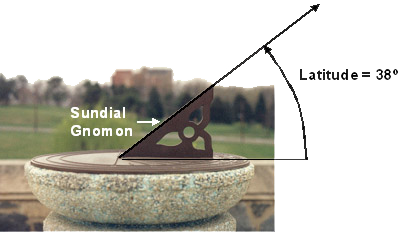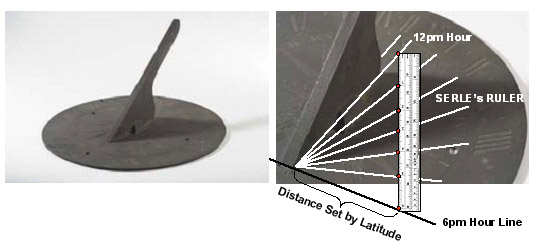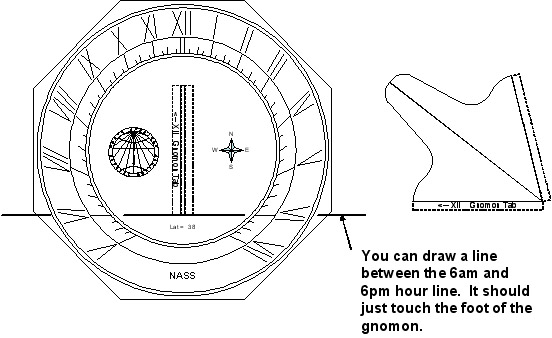This Sundials for Starters appeared in The Compendium in December, 2005
by Robert Kellogg, Ph.D.

This is the start of a regular column to review the basics of Sundials. Of course NASS provides an introductory CD disk on sundials and there is always the classic reference Sundials, Their Theory and Construction by A.E. Waugh.
For this article, let’s consider some basics in buying a sundial for the garden. Or perhpas you want to make one. There are magazine catalogs and websites that offer “fine English dials”. But are they for you? Consider the latitude of an English dial. London is at about 51º north latitude, while most of the populated area of North America is below 45º. Take a look at the gnomon of your potential purchase. The gnomon should be approximately the same angle as you latitude. Here we’ll illustrate a dial (Figure 1) from the Naval Medical Center in Bethesda, Maryland with latitude of approximately 38º.
Make sure that the high side of the gnomon is pointed to the 12pm noon line on the dial plate. You’d be surprised how many store displays have the gnomon put onto its plate backward!
Many people assume that the dial face works for any latitude and all you need is the correctly angled gnomon. Get an English dial, correct the gnomon and have an elegant Southern Carolina sundial. Wrong. The dial plate is also made for a specific latitude. This reminds me of a mystery. At Tudor Place in Washington DC is an old sundial. It’s a horizontal dial about 16 in. square made of bronze, with a small gnomon located at the Peters house (now called Tudor House) built in 1805 and now open as museum to public. Years before this property was opened to the public, Peters brought this dial to Georgetown (now Washington DC) from Crossbasket Castle in Scotland, the family seat. The original gnomon was lost and a crude gnomon was made at an angle of 39°. Serle’s Ruler was used to determine the latitude of the hour lines on the dial plate. Scotland? Hardly. The dial plate hour lines have a latitude of about 48°, that of Augsburg, Germany. This dial was never able to tell correct time either in Scotland or Georgetown.
Last year I had the opportunity to measure the Whitehall sundial in Annapolis, Maryland. The Whitehall house was constructed by Horatio Sharp, who arrived in Maryland from England in August 1753 to replace Governor Samuel Ogle, who had died in office the previous year. The dial itself was made in England by “Heath & Wing - Strand, London” specifically for the Whitehall estate around 1765. Measurement of the dial latitude at about 38º confirmed that it was made for the Chesapeake latitude, as shown in Figure 2:

A measuring instrument designed by George Serle in 1657 (who acknowleged the orgin to Samuel Foster) allows the easy recovery of the hour line latitude. Here is a modern day copy of the ruler Serle used to make sundials. At the end of this article is a downloadable imate of Serle's Ruler so you can print out a paper copy of the ruler and use it yourself lay to find the latitude of a sundial or create sundial hourlines for a dial of your latitude:

The hour scale is laid out between the noon hour and the 6pm hour lines as shown in Figure 2 of the Maryland dial above. The latitude scale is used to measure the distance from the gnomon foot to the intersection point of the hour line scale.Lastly, one more simple check of your sundial. If you draw a line between the 6am and 6pm hour line on the sundial plate, the line should just touch the foot of the gnomon as shown in Figure 4.

You can use your knowledge of sundial basics to make a good sundial purchase from a catalog or store, or you can become a sundial explorer, sleuthing bits of history by closely examining the gnomon angle and the corresponding layout of hour lines on the dial plate.
